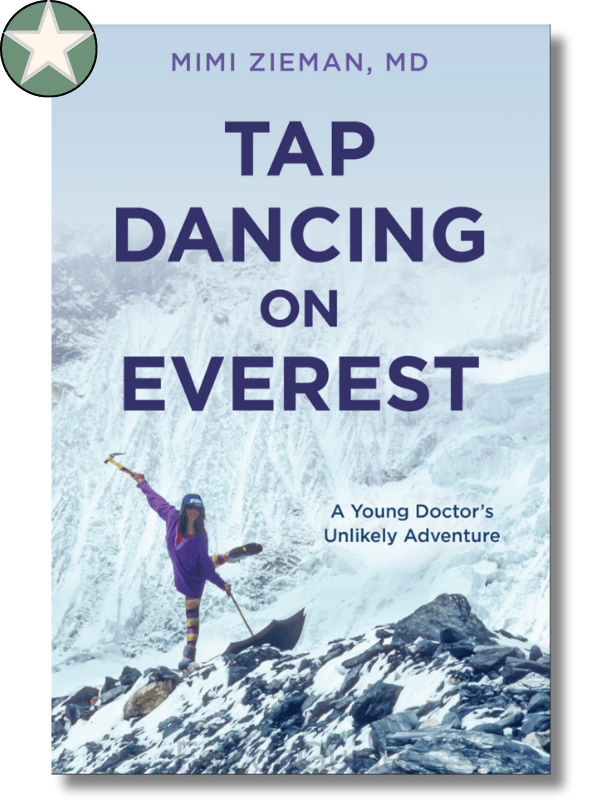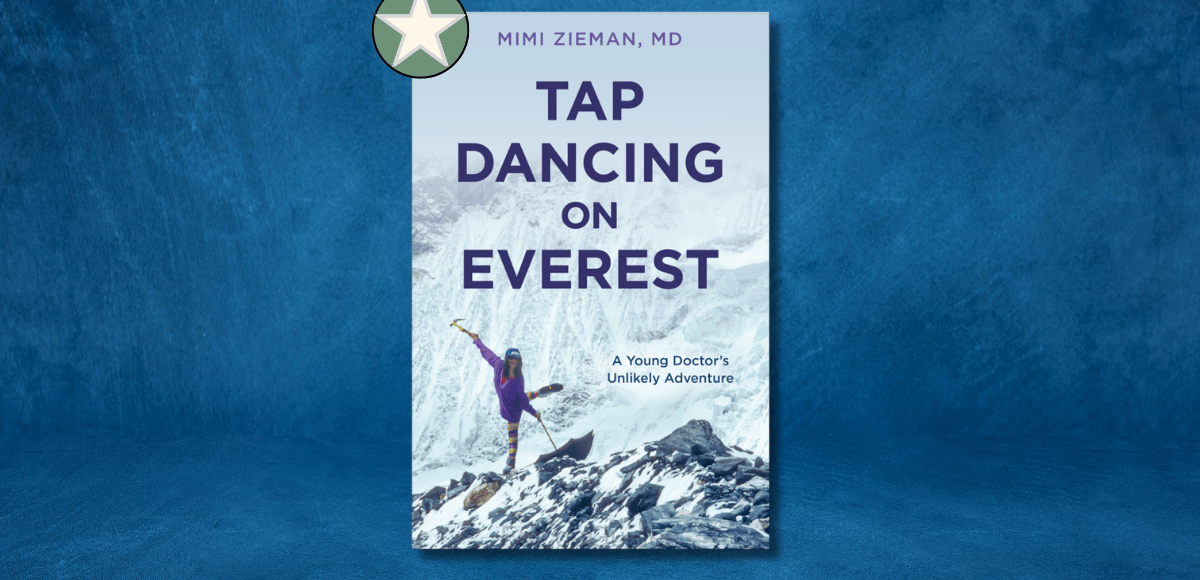
Tap Dancing on Everest
by Mimi Zieman, MD
Genre: Memoir / Climbing
ISBN: 9781493078431
Print Length: 244 pages
Reviewed by Warren Maxwell
A riveting memoir about the travails of growing up, the trauma of mountain climbing, and the elation of being in the great outdoors
Beginning at the dramatic climax of a years-in-the-making expedition to climb Everest’s east face without oxygen for the first time, Zieman’s memoir doubles back to trace the bumpy path that led her to become the team medical officer as a twenty-five year old medical school student.
What materializes is a deep portrait of Mimi’s youth and milieu in New York as the ambitious daughter of two Holocaust survivors. Her father’s entire family was killed in Latvia while her maternal grandmother fled Germany for Palestine with her young daughter, Mimi’s mother. Living with the legacy of such a brutal and incomprehensible past reverberates in Zieman, triggering eating disorders, an unrequited love of dance, and an ultimate turn toward medicine.
While plagued by her family’s expectations and rules, mountains and trekking become an early source of independence. Through a series of split decisions and journeys, Zieman ends up alone in the Nepali Himalayas, hiking for weeks on end and forging relationships with fellow hikers that take her all the way to the feet of Everest.
“Dad’s Yiddish sounded melodic and old country. He nodded with his eyebrows raised when repeating one-liners, like tsvey kluge kenen nit shtimen, or two smart people can’t agree. He laughed with his shoulders heaving up and down when he told classic jokes: Five Jewish women are eating lunch in a busy cafe. Nervously, their waiter approaches the table. ‘Ladies,” he says. “Is anything okay?’”
The majority of this book deals with the lead-up to the now legendary, death-defying climb. In effect, years of striving to overcome various traumas and come into herself culminate in Zieman’s role during the Kangshung expedition to climbing Everest from its Tibetan-Chinese face.
By the time she is anxiously waiting in the advanced base camp for the four climbers to return, safely or otherwise, from their twenty-nine thousand foot ascent, Zieman has grown in courage, self-determination, and confidence. This personal coming of age isn’t a direct object of the book—the memoir is chock full of information and gorgeous detail on the climb, the terrain, and the planning that went into it— yet it’s an ineffable narrative that permeates everything about the text.
“The flat white of day became a black cavern of night. I moved into Joe’s tent, hoping to lessen the crushing weight of emptiness. A tempest outside dropped a wet, heavy snowfall characteristic of a spring monsoon.”
One of the things that’s wonderful about this uncommon approach to writing the mountain climbing narrative—the very fact that Zieman is present as a doctor, not a climber, and doesn’t herself climb Everest—is that we see a different side to the climbing story. Zieman appreciates the adrenaline-less waiting. Her preparation aims at healing an injured body rather than perfecting strength and endurance. This is a tale about the experience of living on mountains, beside mountains, under mountains, and hoping that the people climbing them will survive. The depth of psychology and detail that go into Zieman’s descriptions are mesmerizing.
“To generate interest in our climb, Robert, our expedition leader, had successfully pitched a ‘couch-to-climb’ story to the magazine. The published article featured a photo of me balancing between walls in my apartment building stairwell wearing green medical scrubs on top, purple exercise tights, white ankle socks, and flat sneakers.”
The overall quality of the writing in this book is exceptional. The memoir’s many large and small vignettes, its minor characters and central ones all leap into focus. Whether Zieman’s haunted, psychotherapist father or a braggadocios boy that she rescues in a climbing accident, personality and life abound. Zieman’s grandmother who fled Germany is a quixotic Jewish dancer and former choreographer whose rule-breaking influence hangs over Zieman’s choices. While hiking through Nepal, she recounts getting a stomach bug and enduring days of discomfort and awkward situations while staying with local Nepali families. Even medical school is zoomed in on, becomes the scene of romances, operations, and intense debates.
In short, this memoir travels widely. It brings a large swath of territory into its purview that, while seemingly diffuse, builds to a triumphant peak. It is a beautiful, wrenching story about the trials that we endure and the rewards we reap.
Thank you for reading Warren Maxwell’s book review of Tap Dancing on Everest by Mimi Zieman, MD! If you liked what you read, please spend some more time with us at the links below.


0 comments on “STARRED Book Review: Tap Dancing on Everest”